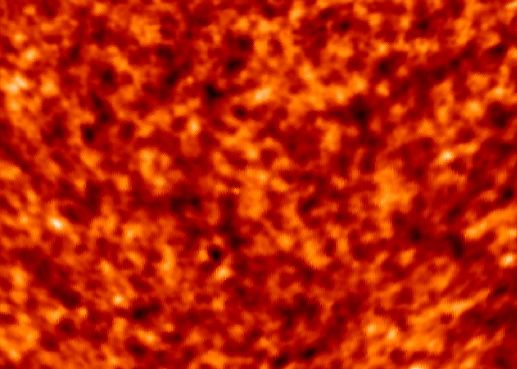Credit & Copyright: BOOMERANG Project
Explanation:
Drifting through the stratosphere above
Antarctica in late
1998, the
balloon-borne
BOOMERANG telescope peered into the
cosmos at millimeter wavelengths.
The blotchy structures it detected are
seen above in the sharpest yet picture of the universe at an
early age,
perhaps a mere 300,000 years old.
The
false-color image shows subtle fluctuations in the temperature of
the hot plasma which
filled the universe before expansion
cooled the material, producing the familiar stars and galaxies.
Dramatically, the size of the fluctuations
in the BOOMERANG image has convinced many
cosmologists
that the universe contains just exactly enough
matter and energy to be
flat -- a
powerful prediction of the popular theory of
Inflation which
describes
the earliest moments of the
Big
Bang.
A flat universe
will expand forever and two light rays which
start out parallel will never spread or intersect.
But all is not solved (!) as the
BOOMERANG
results don't show clearly details confirming the suspected amounts of
dark
matter and the
cosmological
constant.
1999 2000 2001 2002 2003 2004 2005 2006 2007 2008 2009 2010 2011 2012 2013 2014 2015 2016 2017 2018 2019 2020 2021 2022 2023 2024 2025 |
Yanvar' Fevral' Mart Aprel' Mai Iyun' Iyul' Avgust Sentyabr' Oktyabr' Noyabr' Dekabr' |
NASA Web Site Statements, Warnings, and Disclaimers
NASA Official: Jay Norris. Specific rights apply.
A service of: LHEA at NASA / GSFC
& Michigan Tech. U.
|
Publikacii s klyuchevymi slovami:
cosmology - universe - inflation - early universe - big bang - cosmic microwave background radiation - Bol'shoi Vzryv - fluktuacii
Publikacii so slovami: cosmology - universe - inflation - early universe - big bang - cosmic microwave background radiation - Bol'shoi Vzryv - fluktuacii | |
Sm. takzhe:
Vse publikacii na tu zhe temu >> | |
